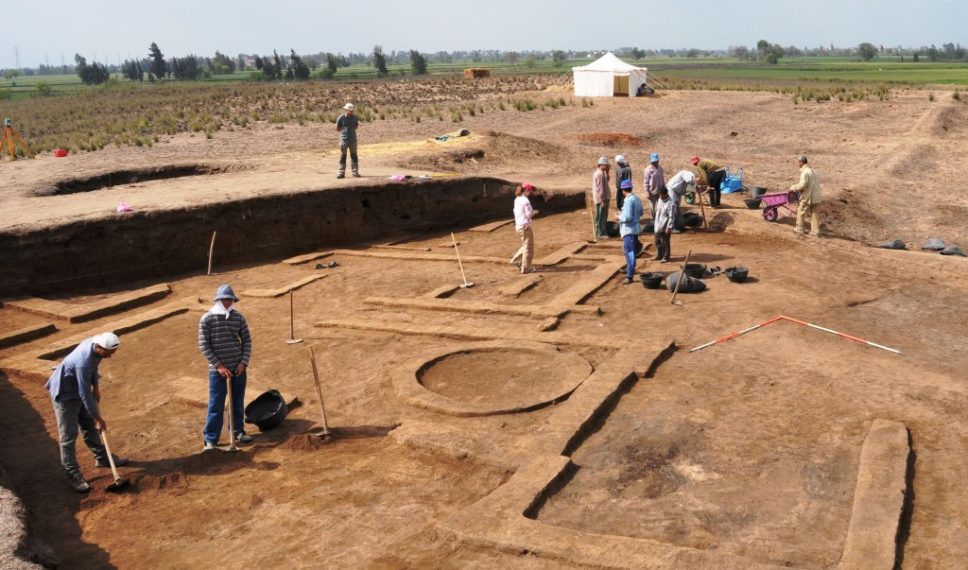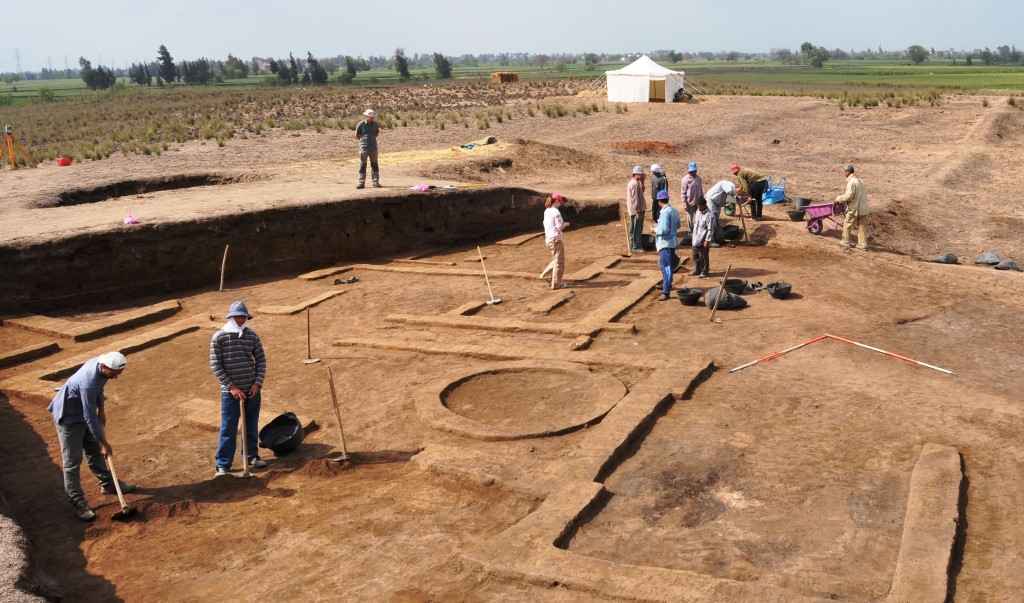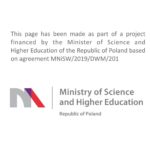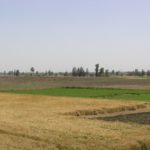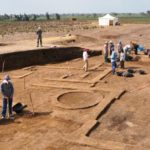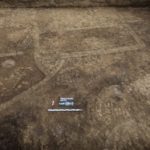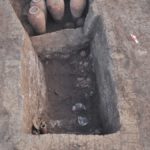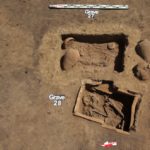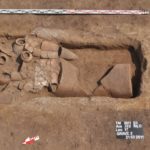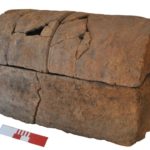Tell el-Murra
-
Project name:
Polish Archaeological Expedition to the North-Eastern Nile Delta
Project website:
-
Type of site:
Settlement, cemetery
Location:
Egypt
Nile Delta
About 100 km north-east from CairoDating:
– Predynastic period (Lower Egyptian culture)
– Early Dynastic period (1st–2nd dynasty)
– Old Kingdom (3rd–6th dynasty)
– Absolute dating: ca. 3500–2200 BC
Most interesting finds:
– Discovery of Lower Egyptian culture remains and determining that the beginnings of the settlement at Tell el-Murra date to about 3500 BC
– Discovery of remains attesting to a very high level of the flooding of the Nile, which probably destroyed a large part of the settlement at the end of the Lower Egyptian culture
– Confirmation of a break in the settlement at Tell el-Murra (in the Naqada IID period) between the decline of the Lower Egyptian culture and the period directly preceding the creation of the Egyptian state
– Acquiring of data on settlement architecture (structures and archaeological material from the times of the 2nd and 3rd dynasties), which is important in light of the small number of excavated settlements from this still insufficiently recognized period
– Uncovering of bread-baking installations
– Noting the difference between the burials from the 1st–2nd dynasty in Tell el-Murra and the ones in other cemeteries in the Delta from the same period
History of research:
Dates of work:
2008, since 2010 yearly
Type of research:
Survey, excavations
Directors:
Mariusz Jucha, Institute of Archeology, Jagiellonian University in Kraków (2008- )
Grzegorz Bąk-Pryc, Institute of Archeology, Jagiellonian University in Kraków (2013- )
Co-operating institutions:
– Institute of Archeology, Jagiellonian University in Kraków
– Polish Centre of Mediterranean Archaeology, University of Warsaw
Additional information:
In 2008, the Polish Archaeological Expedition to the North-Eastern Nile Delta began research work in the Ash-Sharqiyyah Province to locate sites from the turn of the 4th and 3rd millennium BC. Pottery material from this period was discovered on the following sites: Tell el-Murra, Tell Abu el-Halyat, Tell el-Akhdar, Gezira el-Faras, and presumably Minshat Radwan. Tell el-Murra was selected for further investigation.
Research in Tell el-Murra was carried out in the framework of the following projects:
– “Settlements of the Eastern Nile Delta in the Pre- and Early Dynastic periods and their role in the development of trade with the Near East” – project financed by the Ministry of Science and Higher Education (grant no. 2195/B/H03/2009/36, in the course of realization handed over to the National Science Centre), realized from 03.07.2009 to 02.05.2012.
– “Between Southern Egypt and Canaan. The development and decline of Tell el-Murra, a trade route settlement from the 4th–3rd millennium BC” – project financed by the National Science Centre, decision no. DEC-2013/09/B/HS3/03588, realized from 06.02.2014 to 05.12.2016.
Description of the site and research:
Tell el-Murra lies in the eastern part of the Nile Delta, about 100 km north-east from Cairo. The tell, which covers the remains of an ancient settlement and cemetery, rises approximately 3 to 4 m above the surrounding cultivated fields /Fig. 1/.
Tell el-Murra was one of the sites surveyed as part of the project conducted in the years 2008 and 2010–2011 in the Eastern Nile Delta, in the Ash-Sharqiyyah Province. The excavations confirmed the existence of cultural layers dating to the Predynastic, Early Dynastic, and Old Kingdom periods. It means that Tell el-Murra existed for 1300 years (about 3500–2200 BC).
Exploratory works in 2011 focused on three parts of the tell: south-western (trial pits S3 and S2), north-eastern (trial pit S1), and eastern (trial pit S4). The site was selected for further regular archaeological excavations based on the analysis of the material collected from the surface and the trial pits, as well as the results of geophysical research and geological drilling. The pottery found on the surface and in the trial pits (S1, S3, S4) that were explored in 2010–2011 allowed the team to determine the chronology of the settlement. The preliminary dating from about 3500 to about 2200 BC was confirmed during subsequent research carried out in 2014–2016, which also helped distinguish the subsequent phases of development and decline of the settlement.
The oldest settlement was founded in the Predynastic period by the representatives of the Lower Egyptian culture, which had developed in the northern part of Egypt. Its remains have been studied so far in two trenches: S1 (2011) and S4 (2016). Research in 2016 also confirmed earlier assumptions about a break in the settlement in the Naqada IID period, between the decline of the Lower Egyptian culture and the period directly preceding the creation of the Egyptian state.
The site was resettled at the end of the Predynastic period (the so-called Protodynastic period), possibly shortly before the unification of the country. The settlement also functioned in the Early Dynastic period (1st–2nd dynasty) /Fig. 4/. However, it became smaller, and its north-western part, until then occupied by domestic structures, was turned into a cemetery (trench S3). Burials in pottery coffins /Fig. 8/ were often found in the excavated graves from this period /Figs 5, 6, 7/.
During the Old Kingdom (3rd–6th dynasty), the settlement still concentrated only in the eastern (trench S4) and northern (trench T5 and material collected from the surface of the tell) parts of the site /Figs 2, 3/. Research conducted in 2013–2016 showed that despite a short crisis and a decrease in size, Tell el-Murra flourished in the Early Dynastic period (1st–2nd dynasty), and especially in the first part of the Old Kingdom (3rd–4th dynasty). The next decline in importance happened in the second part of the Old Kingdom (5th–6th dynasty), as evidenced by the very modest remains uncovered in 2013–2014. At the end of that period, during the reign of the 6th dynasty, the site was abandoned; no later material has been found to date.
The excavators uncovered extensive settlement structures (domestic buildings, silos, storage pits, bread-baking installations), which provide important information on Egyptian architecture. Small finds from the settlement include numerous querns, grinders, sickle inserts, plant remains, and animal bones. In light of this data, it can be assumed that the inhabitants of Tell el-Murra supported themselves with agriculture, animal husbandry, and fishing. At the same time, the presence of imported objects confirms the existence of contacts with other regions.
The excavations conducted in the cemetery demonstrated the differences between burials on contemporary sites in the Delta. They are especially evident in the case of the pottery coffins, present in Tell el-Murra but completely absent in some of the neighboring cemeteries from the same period (e.g., Tell el-Farkha, Minshat Abu Omar).
Current work carried out in Tell el-Murra encompasses primarily the south-western part of the site (trench S3), where Early Dynastic graves are being uncovered, as well as the older settlement and the north-eastern part of the site (trench T5), where the remains of the settlement functioning to the end of the Old Kingdom are studied.
Associated events:
8–30 September 2016 – Exhibition “Archeo Delta”, Photography Exhibition, Bibliotheca Alexandrina, Alexandria
Organizers: BA Alexandria Center for Hellenistic Studies in cooperation with the Ministry of Antiquities and the University in Padova
Research results:
Season by season – “PCMA Newsletter”:
- 2018 season
- 2017 season
- 2016 season
- 2015 season
- 2014 season
- 2013 season
- 2012 season
- 2011 season
- 2010 season
Chcek also the project’s website for updates.
Jucha, M A., Bąk-Pryc, G., Małecka-Drozd, N., Kazimierczak, M. (2018) Tell el-Murra (Northeastern Nile Delta Survey): research in 2016–2017, Polish Archaeology in the Mediterranean, 27/1, 149–167
Jucha, M A., Bąk-Pryc, G., Małecka-Drozd, N., Kazimierczak, M. (2017). Tell el-Murra (Northeastern Nile Delta Survey): preliminary report on research in 2014–2015, Polish Archaeology in the Mediterranean, 26/1, 135–158.
Jucha, M A., Bąk-Pryc, G. (2017). Settlement and cemetery – new research on the 4th/3rd millennium Nile Delta site at Tell el-Murra In B. Midant-Reynes and Y. Tristant with the collaboration of E.M. Ryan, Egypt at its Origins 5. Proceedings of the Fifth International Conference “Origin of the State. Predynastic and Early Dynastic Egypt” Cairo 13–18 April 2014, (=Orientalia Lovaniensia Analecta 260). (pp. 175–197). Leuven–Paris–Bristol.
Kazimierczak, M. (2017). Settlement pottery from the Old Kingdom Period at Tell el-Murra, Trench T5 In M. Tomorad, J. Popielska-Grzybowska (Eds), Egypt 2015: Perspectives of Research. Proceedings of VIIth European Conference of Egyptologists. Zagreb, Croatia (2–7 June, 2015), (=Archaeopress Egyptology 18), (pp. 175–185). Oxford.
Jucha, M. A, with contributions by Bąk-Pryc, G, Małecka-Drozd, N., Kazimierczak, M., Ownby, M. F., Mądrzyk, K., Pankowska, A., Woźniak & B., Abłamowicz, R. (2016). Polish Excavations at Tell el-Murra in the Nile Delta Preliminary Report 2013–2015, Archeologia, 65, 85–146.
Jucha, M. A. & Bąk-Pryc, G. (2016). Trench S3 – Cemetery. In M.A. Jucha with contributions by G. Bąk-Pryc at al., Polish Excavations at Tell el-Murra in the Nile Delta Preliminary Report 2013–2015, Archeologia, 65, 2014, 88–100.
Małecka-Drozd, N. (2016). Trench T5 – Settlement. In M. A. Jucha with contributions by G. Bąk-Pryc at al., Polish Excavations at Tell el-Murra in the Nile Delta Preliminary Report 2013–2015, Archeologia 65, 2014, 101–113.
Kazimierczak, M. (2016). The Pottery from the Graves – Trench S3. In M.A. Jucha with contributions by G. Bąk-Pryc at al., Polish Excavations at Tell el-Murra in the Nile Delta Preliminary Report 2013–2015, Archeologia 65, 2014, 113–121.
Kazimierczak, M. (2016). The Pottery from the Settlement – Trench T5. In M.A. Jucha with contributions by G. Bąk-Pryc at al., Polish Excavations at Tell el-Murra in the Nile Delta Preliminary Report 2013–2015, Archeologia, 65, 2014, 121–127.
Ownby, M. F. (2016). Petrographic Analysis of the Pottery. In M.A. Jucha with contributions by G. Bąk-Pryc at al., Polish Excavations at Tell el-Murra in the Nile Delta Preliminary Report 2013–2015, Archeologia, 65, 2014, 127–131.
Bąk-Pryc, G. (2016). Stone Vessels. In M. A. Jucha with contributions by G. Bąk-Pryc at al., Polish Excavations at Tell el-Murra in the Nile Delta Preliminary Report 2013–2015, Archeologia, 65, 2014: 131–135.
Mądrzyk, K., Pankowska, A., Woźniak, B. (2016). Anthropological Research. In M.A. Jucha with contributions by G. Bąk-Pryc at al., Polish Excavations at Tell el-Murra in the Nile Delta Preliminary Report 2013–2015, Archeologia, 65, 2014, 135–139.
Abłamowicz, R. (2016). Archaeozoological Research. In M.A. Jucha with contributions by G. Bąk-Pryc at al., Polish Excavations at Tell el-Murra in the Nile Delta Preliminary Report 2013–2015, Archeologia, 65, 2014, 140–143.
Jucha, M. A. (2016). The northeastern part of the Nile Delta during the Naqada III Period. In M.D. Adams (Ed.), B. Midant-Reynes, E. M. Ryan, Y. Tristant (coll.), Proceedings of the Fourth International Conference “Origin of the State. Predynastic and Early Dynastic Egypt”, New York, 26th–30th July 2011, (=Orientalia Lovaniensia Analecta 252), Leuven–Paris–Bristol, CT, 63–76.
Kazimierczak, M. (2016). Potmarks from Tell el-Murra and Tell el-Farkha cemeteries (seasons 2011–2016), Studies in Ancient Art And Civilization, 20, 7–18.
Kazimierczak, M. (2016). The pottery from Early Dynastic cemetery at Tell el-Murra: Seasons 2011–2014. In M. Kajzer, Ł. Miszk & M, Wacławik (Eds.) The Land of Fertility, South-east of the Mediterranean from the beginning of the Bronze Age to the Muslim Conquest (pp. 3–18). Newcastle upon Tyne.
Jucha, M. A. (2015). Tell el-Murra 2008–2015. Excavation of the Nile Delta site from the IVth–IIIrd Millennia BC. Journal of Ancient Egyptian Interconnections, 7.4, 71–74.
Jucha, M. A., Bąk-Pryc, G., Małecka-Drozd, N. (2015). Tell el-Murra (North-Eastern Nile Delta Survey) Seasons 2012–2013, Polish Archaeology in the Mediterranean, 24/1, 199–214
Kazimierczak, M. (2015). Beer jars from Tell el-Murra graves (seasons 2011–2015), Studies in Ancient Art and Civilization, 19, 7–17.
Jucha, M. A., Bąk-Pryc, G., Czarnowicz, M. (2014). Tell el-Murra (Northeastern Nile Delta Survey) Season 2011, Polish Archaeology in the Mediterranean, 23/1, 141–152.
Jucha, M. A. (2014). The Nile Delta since the end of the Lower Egyptian Culture until the beginning of Egyptian State. In M. A. Jucha, J. Dębowska-Ludwin, P. Kołodziejczyk (Eds.), Aegyptus Est Imago Caeli, Studies Presented to Krzysztof M. Ciałowicz on his 60th Birthday (pp. 19–35). Kraków.
Małecka-Drozd, N. (2014). The settlement landscape in the Nile Delta of the third millennium. In M. A. Jucha, J. Dębowska-Ludwin, P. Kołodziejczyk (Eds.), Aegyptus Est Imago Caeli, Studies Presented to Krzysztof M. Ciałowicz on his 60th Birthday (pp. 57–62). Kraków.
Kazimierczak, M. (2014). Naczynia ceramiczne z wczesnodynastycznego cmentarzyska w Tell el-Murra: sezony 2011–2012 (=Medżat: Studia Egiptologiczne II) (pp. 47–67). Warszawa.
Kazimierczak, M. (2014). Pottery from Tell el-Murra Graves. Seasons 2011–2012, Studies in Ancient Art and Civilization, 18, 101–118.
Kazimierczak, M. (2014). Meidum bowls from Tell el-Murra trench T5 (Season 2013). In M. A. Jucha, J. Dębowska-Ludwin & P. Kołodziejczyk (Eds.), Aegyptus est Imago Caeli. Studies Presented to Krzysztof M. Ciałowicz on His 60th Birthday (pp. 161–167). Kraków.
Jucha, M. A., Błaszczyk, K., Buszek, A. & Pryc, G. (2013). Tell el-Murra (Northeastern Nile Delta Survey). Season 2010, Polish Archaeology in the Mediterranean, 22, 105–120.
Jucha, M. A. (2013). Tell el-Murra – results of survey and prospects for research, Studies in Ancient Art and Civilization, 17, 53–66.
Jucha, M. A. (2012). Naqada III-Old Kingdom pottery in the Nile Delta: a view from Tell el-Akhdar, Studies in Ancient Art and Civilization, 16, 49–60.
Jucha, M. A. (2011). Tell Abu el-Halyat. The new Naqada III – Old Kingdom (?) site in the North Eastern Nile Delta, Studies in Ancient Art and Civilization, 15, 65–76.
Jucha, M. A. & Buszek, A. (2011). Tell el-Murra (North-Eastern Nile Delta Survey). Season 2008, Polish Archaeology in the Mediterranean, 20, 177–182.
Jucha, M. A. (2011). The Polish archaeological survey in the north-eastern part of the Nile Delta (season 2010) – the pottery from Tell el-Murra and Tell Abu el-Halyat, Recherches Archeologiques, Nouvelle Serie, 3, 179–194.
Jucha, M. A. (2010). Tell el-Murra. The Predynastic – Old Kingdom site in the North-Eastern Nile Delta. Folia Orientalia, XLVII, 379–390.
Jucha, M. A. (2010). Tell el-Murra. The Polish Archaeological Survey in Ash-Sharqiyyah Governorate (Egypt, the Nile Delta), Recherches Archéologiques. Nouvelle Serie, 2, 229–237.
Jucha, M. A. (2009). The North-Eastern Part of the Nile Delta – Research Perspectives. Polish Archeological Survey in the Ash-Sharqiyyah Governorate. In J. Popielska-Grzybowska & J. Iwaszczuk, Proceedings of the Fifth Central European Conference of Egyptologists. Egypt 2009: Perspectives of Research, Pułtusk 22-24 June 2009, (=Acta Archaeologica Pultuskiensia, vol. II) (pp. 83–88, Fig. 33–41). Pułtusk.
Gallery:
-
1. Tell el-Murra (fot. M. A. Jucha)
-
2. Tell el-Murra. Settlement, Old Kingdom / Tell el-Murra. Osada, Stare Państwo (fot. M. A. Jucha)
-
3. Tell el-Murra. Settlement, Old Kingdom / Tell el-Murra. Osada, Stare Państwo (fot. M. A. Jucha)
-
4. Tell el-Murra. Settlement, Early Dynastic period / Tell el-Murra. Osada, Okres wczesnodynastyczny (fot. Ewa Kuciewicz)
-
5. Tell el-Murra. Cemetery, Grave 1. Early Dynastic period / Tell el-Murra. Cmentarzysko, grób nr 1. Okres wczesnodynastyczny (fot. G. Bąk-Pryc)
-
6. Tell el-Murra. Cemetery, Graves 27 and 28. Early Dynastic period / Tell el-Murra. Cmentarzysko, groby 27 i 28. Okres wczesnodynastyczny (fot. Ewa Kuciewicz)
-
7. Tell el-Murra. Cemetery, Grave 2. Early Dynastic period / Tell el-Murra. Cmentarzysko, Grób 2. Okres wczesnodynastyczny (fot. Grzegorz Bąk-Pryc)
-
8. Tell el-Murra. Cemetery, pottery coffin, Grave 2. Early Dynastic period / Tell el-Murra. Cmentarzysko, ceramiczna trumna, grób nr 2. Okres wczesnodynastyczny (fot. M. A. Jucha)

